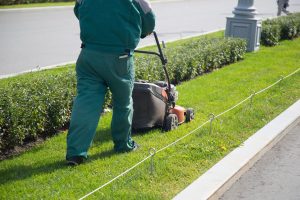
How to Mow Around a Pond Edges
Maintaining the grounds around a pond is more complicated than straightforward lawn care. Should you be using a weed wacker or a lawn mower? Besides, there’s the fact that the terrain is often uneven, so safety becomes a paramount concern.
But with the right tools and techniques, including specialized mowers and trimmers, you can make your lawn look polished while protecting the pond. Below, we offered a more in-depth look into how to mow around a pond effectively and safely.
Tools to Consider
Brush Mower
This is ideal for mowing overgrown pond banks with thick brush and weeds. It’s a heavy-duty mower that can handle challenging terrains like pond areas.
Sickle Bar Mower
Sickle bar mowers are excellent for cutting grass on slopes and uneven terrains. Hence, they are a good option for mowing pond banks. Sickle Bar Mower easily reaches over the edge without putting the operator at risk.
Boom Mower
For larger properties, a boom mower can be attached to a tractor (like a John Deere) to extend its reach. With this tool, you can mow difficult-to-reach pond banks.
Push Mower
A standard push mower works for flatter areas near the pond. It offers more control but may not be suited for steep or uneven pond banks.
String Trimmer or Weed Eater
These are crucial for getting into those hard-to-reach spots around rocks or near the pond edge. They are also helpful in maintaining a buffer zone of longer grass around the pond.
Sickle Mower
Like sickle bar mowers, sickle mowers can handle taller grass and are helpful if the pond bank has grown a bit wild.
Safety Precautions For Mowing Your Pond Area
Wear Appropriate Gear
To begin with, make sure you have all the necessary safety equipment. This includes safety goggles, gloves, and sturdy boots with good grip—especially when mowing damp and slippery pond banks.
Inspect the Area
Before firing up any machinery, walk around the area. Look for obstacles like rocks, roots, or holes that could be hazardous when figuring out how to mow around a pond.
Understand Your Machinery
Ensure you’re familiar with your equipment’s operating instructions and safety features. Regardless of whether you’re operating a John Deere tractor with a boom mower attachment or a handheld string trimmer,
Plan Your Approach – Techniques and Strategies

Mowing Perimeter
Buffer Zone
Decide how close you want to mow around the pond edge. It’s often a great idea to leave a natural buffer of longer grass and native plants to protect the pond’s ecosystem and reduce erosion on the pond banks.
Slope Considerations
If you have sloping pond banks, consider the mower best suited for this. Brush and sickle bar mowers are designed to handle uneven and sloped terrain. So, they are typically ideal for mowing pond banks.
Mowing Direction and Sequence
Directional Strategy
One technique is to mow parallel to the pond, starting from the outer edges and mow close to the water. This approach minimizes the risk of accidentally discharging clippings into the pond.
Order of Operations
First, using a string trimmer or weed eater may be the most efficient way to trim around rocks, trees, or any areas where the grass meets the pond edge. Then, use your push mower, brush mower, or sickle bar mower to handle the larger expanses of grass.
Sequence
If you’re using multiple types of mowers, for instance, plan your mowing sequence to minimize machine changes and to be more effective.
Handling Various Scenarios
Sickle Bar Mowers for Slopes
If you are dealing with steep slopes on your pond banks, a sickle bar mower can be an excellent choice. These mowers are excellent for uneven and sloped terrains, making it easier to maintain challenging areas safely.
Zero Turn Mowers
While these are generally not recommended for steep slopes due to the risk of tipping, they can be efficient for mowing close to the pond edge on flat terrains. Zero-turn mowers offer excellent maneuverability. With this tool, you can navigate rocks and other obstacles effortlessly.
Handling Different Types of Vegetation
Cutting Vegetation
Different types of vegetation around a pond may require different approaches. While a string trimmer may suffice for cutting grass and lighter weeds, you may need a heavy-duty brush mower for tackling thicker vegetation like cattails.
Riparian Zone
This interface between land and water is often rich with unique vegetation. If you have a small pond, you may manually trim the riparian zone to have better control over the other process.
Grass Carp
For aquatic vegetation control, introducing grass carp can be an ecological way to keep underwater plants in check. Thus, you can reduce the mowing and trimming needed at the water’s edge.
Protecting the Pond’s Ecosystem
Chemical Avoidance
Chemicals in fertilizers and pesticides can wreak havoc on a pond’s ecosystem. Stop short of the pond area to ensure no chemical runoff if you treat your lawn.
Natural Buffers
As mentioned, leaving a riparian zone of native vegetation around the pond is a natural filtration system. It also prevents pond bank erosion.
Heavy-Duty Concerns
While heavy-duty equipment like brush mowers are effective for cutting vegetation, they may disturb the soil and contribute to erosion if not used carefully. Always assess the environment before engaging in heavy-duty mowing.
Cattails and Other Aquatic Plants
While cattails may look charming, they may quickly become invasive. We recommend manual removal or the use of specific tools to cut them. However, some aquatic plants are essential for a balanced pond ecosystem.
Animal Safety
Finally, if your pond is home to animals like frogs, fish, or birds, be extra cautious. Noise and physical disturbance from mowing can stress wildlife, so try to minimize your impact as much as possible.
Cleanup – The Final Step for a Polished Look
While there are tons of pond ideas to make you pond look stunning, one of the most basic of them is cleaning up after mowing.
Remove Clippings and Debris
Collecting Grass Clippings
Leftover grass clippings can decay and cause nutrient imbalances in your pond, leading to issues like algae blooms. Use a rake or pool filter to gather stray clippings that have landed close to or in the water.
Aquatic Plant Remnants
If you’ve cut down cattails or other aquatic plants, remove these from the water and the surrounding area. They can also contribute to nutrient imbalance if left to decay.
Heavy-Duty Cleanup
After using heavy-duty mowers like brush mowers, there may be more debris left behind. Collect these to prevent them from entering the pond and harming aquatic life.
String Trimmer and Weed Eater Cleanup
Small fragments from string trimmers and weed eaters scatter easily. Clean these up carefully, especially from the riparian zone and water’s edge.
Equipment Maintenance
Inspect and Clean
Whether using a zero-turn mower or a traditional push mower, inspect your equipment for any damage. Always clean it to remove any residual plant material or mud.
Blade Care
Sickle bars, brushes, and even push mowers perform best and are safest when their blades are sharp and free from rust or damage. Hence, inspect and sharpen the blades as needed.
Storage
Store all your equipment in a dry, safe place to prolong its lifespan and keep it in optimal condition for the next mowing session.
Summary
Mowing around a backyard pond is not just about achieving aesthetic beauty. But also about maintaining the delicate balance of the ecosystem. Taking care of specific challenges, like navigating steep slopes and different vegetation types, you can take appropriate actions that are both effective and considerate of the environment.
